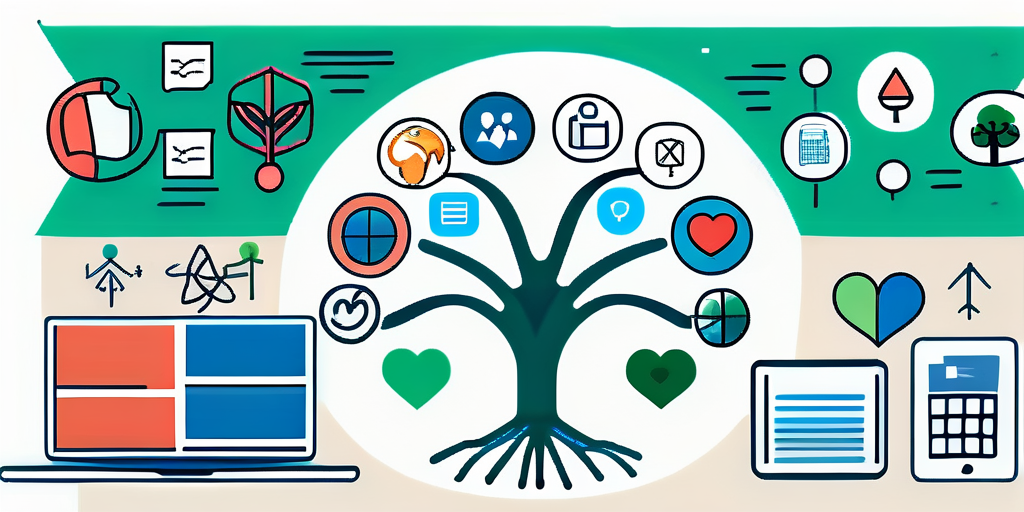The Ultimate Guide to Microsoft Office for Nonprofits

In today’s digital era, technology has become an integral part of nonprofit organizations, enabling them to streamline their operations and better serve their communities. One such technology that has revolutionized the nonprofit sector is Microsoft Office. With its powerful suite of productivity tools, Microsoft Office offers nonprofits the ability to enhance their workflow, increase efficiency, and communicate effectively.
Understanding the Importance of Microsoft Office for Nonprofits
Before diving into the specifics of Microsoft Office, it is essential to grasp its significance in the context of nonprofit operations. From managing day-to-day tasks to organizing data and creating impactful presentations, Microsoft Office plays a pivotal role in helping nonprofits achieve their goals. By leveraging the various tools available, nonprofit organizations can optimize their processes and focus on making a difference in the world.
Nonprofits rely on Microsoft Office for a multitude of tasks, including donor management, grant writing, and volunteer coordination. The software’s versatility allows organizations to create professional documents, track financial data, and analyze key metrics to measure their impact. With Microsoft Office, nonprofits can operate more efficiently and effectively, ultimately furthering their mission to serve their communities.
The Role of Microsoft Office in Nonprofit Operations
Microsoft Office encompasses a range of applications that cater to diverse needs within nonprofit organizations. From word processing with Word to data analysis with Excel, these tools empower nonprofits to streamline their administrative tasks, create engaging content, and facilitate effective communication. Furthermore, Microsoft Office enables seamless collaboration between team members, fostering teamwork and efficiency.
Moreover, Microsoft Office offers cloud-based solutions through Office 365, allowing nonprofits to access their files from anywhere and collaborate in real-time. This flexibility is particularly beneficial for organizations with remote teams or multiple office locations. By harnessing the power of cloud computing, nonprofits can enhance their productivity and adapt to the evolving demands of the digital age.
Key Microsoft Office Tools for Nonprofits
Within the Microsoft Office suite, there are several essential tools that nonprofits should be familiar with to make the most of this powerful software. These include Word, Excel, PowerPoint, and Outlook. Understanding how these tools can be utilized to their fullest potential is crucial for nonprofits looking to optimize their operations and maximize their impact.
Word enables nonprofits to create professional documents such as grant proposals, newsletters, and reports. Excel is instrumental in managing budgets, tracking donations, and analyzing fundraising efforts. PowerPoint allows organizations to design compelling presentations for donor meetings and community events. Outlook streamlines communication through email management and calendar coordination, ensuring that nonprofits stay organized and connected with their stakeholders.
Getting Started with Microsoft Office
Now that the importance of Microsoft Office has been established, it’s time to delve into how nonprofit organizations can get started with this powerful software.
Microsoft Office is a versatile suite of applications that can greatly enhance the productivity and efficiency of nonprofit organizations. From creating impactful presentations to managing complex data in spreadsheets, Microsoft Office offers a wide range of tools to streamline daily operations and communication within the organization.
Setting Up Microsoft Office for Your Nonprofit
Before diving into Microsoft Office’s various applications, it is important to ensure that the software is properly set up and configured for your nonprofit organization. This involves installing the suite, activating licenses, and customizing the settings to align with your specific requirements.
Additionally, setting up cloud storage solutions such as OneDrive can facilitate seamless collaboration among team members, allowing for real-time editing and sharing of documents. Integrating Microsoft Office with other productivity tools commonly used in nonprofits, such as project management software or donor management systems, can further enhance workflow efficiency.
Essential Microsoft Office Training for Nonprofit Teams
Once Microsoft Office is set up, it is vital to provide comprehensive training to nonprofit teams. This ensures that employees and volunteers have a strong foundation in using the tools effectively. Training sessions can cover topics such as creating documents, managing spreadsheets, designing professional presentations, and navigating Outlook for efficient communication.
Moreover, advanced training in specialized applications like Microsoft Access for database management or Microsoft Publisher for creating marketing materials can empower nonprofit staff to leverage the full capabilities of the software suite. Ongoing training and skill development opportunities can help nonprofit organizations stay current with the latest features and functionalities introduced in Microsoft Office updates.
Deep Dive into Microsoft Office Applications
With a solid understanding of the fundamentals, nonprofit organizations can now explore the capabilities of each Microsoft Office application and leverage them to drive their mission forward.
Maximizing the Use of Word for Nonprofits
Word is a versatile tool that can be used for a variety of purposes within a nonprofit organization. From writing grant proposals and reports to creating newsletters and marketing materials, Word provides the flexibility and professional touch needed to effectively communicate and engage with stakeholders.
When it comes to grant proposals, Word offers a range of features to help nonprofits craft compelling narratives. With its formatting options, organizations can easily structure their proposals, making them visually appealing and easy to read. Additionally, Word’s spell-check and grammar-check tools ensure that the final document is error-free, enhancing the professionalism of the proposal.
Moreover, Word’s collaboration capabilities enable multiple team members to work on a document simultaneously, making it easier to gather input and incorporate feedback. Nonprofits can also track changes made to the document, allowing for transparent and efficient collaboration.
Leveraging Excel for Data Management
Data management is a critical aspect of nonprofit operations, and Excel serves as a powerful tool to handle this task. By leveraging Excel’s advanced features, nonprofits can track donations, manage budgets, analyze data, and generate insightful reports, enabling informed decision-making.
Excel’s ability to handle large datasets and perform complex calculations makes it an invaluable asset for nonprofits. Organizations can use Excel’s formulas and functions to automate calculations, saving time and reducing the risk of errors. Additionally, Excel’s data visualization tools, such as charts and graphs, allow nonprofits to present data in a visually appealing and easy-to-understand format, facilitating effective communication with stakeholders.
Furthermore, Excel’s sorting and filtering capabilities enable nonprofits to organize and analyze data efficiently. Nonprofits can easily filter data based on specific criteria, making it easier to identify trends and patterns. This valuable insight can inform strategic decisions and help nonprofits optimize their operations.
Utilizing PowerPoint for Effective Presentations
Presentations are a key component of nonprofit communication strategies, whether it be for fundraising events, board meetings, or community presentations. PowerPoint offers a myriad of features to create visually appealing and engaging presentations that effectively convey the organization’s message and impact.
With PowerPoint’s extensive library of templates and themes, nonprofits can create professional-looking presentations with ease. These templates provide a cohesive visual identity, ensuring that the organization’s branding is consistent across all materials. Nonprofits can also customize these templates to align with their specific needs and preferences.
Moreover, PowerPoint’s multimedia capabilities allow nonprofits to incorporate images, videos, and audio into their presentations, making them more engaging and memorable. Nonprofits can also use animations and transitions to add visual interest and guide the audience’s attention. These features help nonprofits deliver impactful presentations that leave a lasting impression on their stakeholders.
Streamlining Communication with Outlook
Effective communication is crucial for nonprofit organizations, and Outlook serves as a comprehensive email and calendar management tool. It enables nonprofits to manage their email correspondence, schedule meetings, and collaborate seamlessly with team members, ensuring everyone is on the same page.
Outlook’s email management features, such as folders and filters, help nonprofits stay organized and prioritize incoming messages. Nonprofits can create folders to categorize emails based on different projects or stakeholders, making it easier to locate specific information when needed. Additionally, Outlook’s powerful search functionality allows nonprofits to quickly find emails or attachments, saving valuable time.
Furthermore, Outlook’s calendar feature enables nonprofits to schedule and manage meetings efficiently. Nonprofits can send meeting invitations, track responses, and even book conference rooms directly from Outlook. This streamlines the scheduling process and ensures that all team members are aware of upcoming meetings and events.
Collaboration is made seamless with Outlook’s ability to share calendars and schedule meetings with external partners. Nonprofits can easily coordinate with donors, volunteers, and other stakeholders, ensuring effective communication and alignment of schedules.
Advanced Features of Microsoft Office for Nonprofits
Once nonprofit organizations have mastered the core functionalities of Microsoft Office, they can explore advanced features that further optimize their operations and enhance collaboration.
Collaborating with Teams Using Microsoft Office
Nonprofits often work in teams, and Microsoft Office provides robust collaboration features that allow team members to co-author documents, share files, and track changes in real-time. By leveraging these features, nonprofits can promote efficient teamwork, improve productivity, and streamline their collaborative efforts.
Automating Tasks with Microsoft Office
Automation is a valuable resource for nonprofits seeking to save time and reduce manual work. Microsoft Office offers various automation tools, such as macros and templates, that can simplify repetitive tasks, enhance accuracy, and free up valuable resources to focus on the organization’s mission.
Troubleshooting Common Microsoft Office Issues
While Microsoft Office is a powerful tool, occasional issues may arise that hinder productivity. Understanding how to troubleshoot and resolve these issues is essential for nonprofit organizations to ensure smooth and uninterrupted operations.
Resolving Technical Glitches in Microsoft Office
Technical glitches can occur in any software, and Microsoft Office is no exception. From software crashes to compatibility issues, being equipped with troubleshooting techniques can help nonprofits swiftly resolve these glitches and minimize downtime.
Addressing Compatibility Issues in Microsoft Office
With the ever-evolving technology landscape, compatibility issues may arise when working with different versions of Microsoft Office or when collaborating with external stakeholders. Nonprofits should be aware of these potential issues and adopt strategies to address them effectively.
As a nonprofit organization looking to optimize your operations, it is important to recognize the immense power and value that Microsoft Office offers. By understanding the importance of Microsoft Office, mastering its core applications, exploring advanced features, and equipping yourself with troubleshooting techniques, your nonprofit can leverage this ultimate guide to drive efficiency, collaboration, and ultimately make a greater impact on the communities you serve.
Ready to take your nonprofit’s digital presence to the next level? BlueWing is here to help you harness the power of paid social media and search to amplify your impact. With our expertise in the Google Ad Grants program and a commitment to sustainable growth, we’ll manage your paid media campaigns and keep you updated every step of the way. Experience the difference eight years of exceeding industry benchmarks can make. Contact us today and let’s build a brighter future together.





